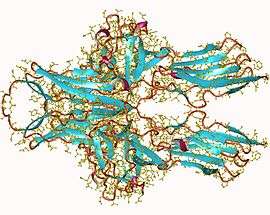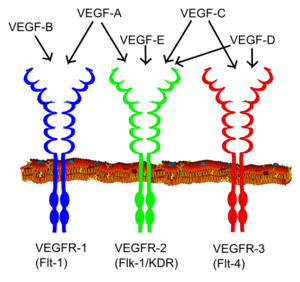VEGF receptor
VEGF receptors are receptors for vascular endothelial growth factor (VEGF).[1][2] There are three main subtypes of VEGFR, numbered 1, 2 and 3. Also, they may be membrane-bound (mbVEGFR) or soluble (sVEGFR), depending on alternative splicing.[3]
VEGF
Vascular endothelial growth factor (VEGF) is an important signaling protein involved in both vasculogenesis (the formation of the circulatory system) and angiogenesis (the growth of blood vessels from pre-existing vasculature). As its name implies, VEGF activity is restricted mainly to cells of the vascular endothelium, although it does have effects on a limited number of other cell types (e.g. stimulation monocyte/macrophage migration). In vitro, VEGF has been shown to stimulate endothelial cell mitogenesis and cell migration. VEGF also enhances microvascular permeability and is sometimes referred to as vascular permeability factor.
Receptor biology
All members of the VEGF family stimulate cellular responses by binding to tyrosine kinase receptors (the VEGFRs) on the cell surface, causing them to dimerize and become activated through transphosphorylation. The VEGF receptors have an extracellular portion consisting of 7 immunoglobulin-like domains, a single transmembrane spanning region and an intracellular portion containing a split tyrosine-kinase domain.
VEGF-A binds to VEGFR-1 (Flt-1) and VEGFR-2 (KDR/Flk-1). VEGFR-2 appears to mediate almost all of the known cellular responses to VEGF.[1] The function of VEGFR-1 is less well defined, although it is thought to modulate VEGFR-2 signaling. Another function of VEGFR-1 is to act as a dummy/decoy receptor, sequestering VEGF from VEGFR-2 binding (this appears to be particularly important during vasculogenesis in the embryo). In fact, an alternatively spliced form of VEGFR-1 (sFlt1) is not a membrane bound protein but is secreted and functions primarily as a decoy.[6] A third receptor has been discovered (VEGFR-3), however, VEGF-A is not a ligand for this receptor. VEGFR-3 mediates lymphangiogenesis in response to VEGF-C and VEGF-D.
In addition to binding to VEGFRs, VEGF binds to receptor complexes consisting of both neuropilins and VEGFRs. This receptor complex has increased VEGF signalling activity in endothelial cells (blood vessels).[7][8] Neuropilins (NRP) are pleitrophic receptors and therefore other molecules may interfere with the signalling of the NRP/VEGFR receptor complexes. For example, Class 3 semaphorins compete with VEGF165 for NRP binding and could therefore regulate VEGF-mediated angiogensis.[9]
VEGFR antagonists
Some VEGFR antagonists (inhibitors) (for example lenvatinib, motesanib) are under investigation for treating various cancers. Pazopanib was approved for renal cell carcinoma in 2009. Regorafenib was approved for colorectal cancer in Sept 2012.
References
- 1 2 Holmes K, Roberts OL, Thomas AM, Cross MJ (Oct 2007). "Vascular endothelial growth factor receptor-2: structure, function, intracellular signalling and therapeutic inhibition.". Cell Signal. 19 (10): 2003–2012. doi:10.1016/j.cellsig.2007.05.013. PMID 17658244.
- ↑ Stuttfeld E, Ballmer-Hofer K (September 2009). "Structure and function of VEGF receptors". IUBMB Life. 61 (9): 915–22. doi:10.1002/iub.234. PMID 19658168.
- ↑ Fujita, N.; Imai, J.; Suzuki, T.; Yamada, M.; Ninomiya, K.; Miyamoto, K.; Iwasaki, R.; Morioka, H.; Matsumoto, M.; Chiba, K.; Watanabe, S.; Suda, T.; Toyama, Y.; Miyamoto, T. (2008). "Vascular endothelial growth factor-A is a survival factor for nucleus pulposus cells in the intervertebral disc". Biochemical and Biophysical Research Communications. 372 (2): 367–372. doi:10.1016/j.bbrc.2008.05.044. PMID 18492486.
- ↑ cancerpublications.com.
- ↑ Interactions of VEGF ligands and VEGF receptors ResearchVEGF.com, retrieved on November 13, 2009
- ↑ Zygmunt T, Gay CM, Blondelle J, Singh MK, Flaherty KM, Means PC, Herwig L, Krudewig A, Belting HG, Affolter M, Epstein JA, Torres-Vázquez J (August 2011). "Semaphorin-PlexinD1 Signaling Limits Angiogenic Potential via the VEGF Decoy Receptor sFlt1". Dev Cell. 21 (2): 301–314. doi:10.1016/j.devcel.2011.06.033. PMC 3156278
 . PMID 21802375.
. PMID 21802375. - ↑ Soker, S.; Takashima, S.; Miao, H. Q.; Neufeld, G.; Klagsbrun, M. (1998). "Neuropilin-1 is expressed by endothelial and tumor cells as an isoform-specific receptor for vascular endothelial growth factor". Cell. 92 (6): 735–745. doi:10.1016/s0092-8674(00)81402-6. ISSN 0092-8674. PMID 9529250.
- ↑ Herzog, B; Pellet-Many, C; Britton, G; Hartzoulakis, B; Zachary, I. C. (2011). "VEGF binding to NRP1 is essential for VEGF stimulation of endothelial cell migration, complex formation between NRP1 and VEGFR2, and signaling via FAK Tyr407 phosphorylation". Molecular Biology of the Cell. 22 (15): 2766–2776. doi:10.1091/mbc.E09-12-1061. ISSN 1939-4586. PMC 3145551
 . PMID 21653826.
. PMID 21653826. - ↑ Mecollari, V; Nieuwenhuis, B; Verhaagen, J (2014). "A perspective on the role of class III semaphorin signaling in central nervous system trauma". Frontiers in Cellular Neuroscience. 8: 328. doi:10.3389/fncel.2014.00328. PMC 4209881
 . PMID 25386118.
. PMID 25386118.
External links
- VEGF Receptors at the US National Library of Medicine Medical Subject Headings (MeSH)
- Proteopedia Vascular_Endothelial_Growth_Factor_Receptor - the Vascular Endothelial Growth Factor Receptor Structure in Interactive 3D

